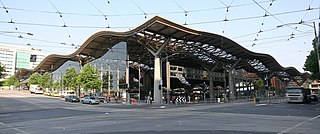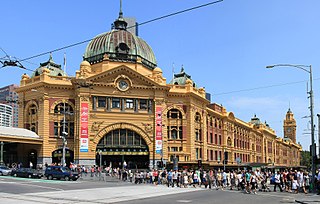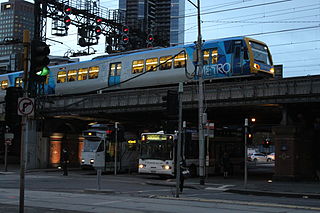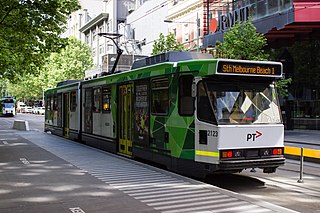See also
- Circle City (disambiguation)
- City Loop, a subway and rail loop in central Melbourne, Australia
The City Circle is a largely-underground railway line in central Sydney, Australia.
City Circle may also refer to:

Trams are a major form of public transport in Melbourne, the capital city of the state of Victoria, Australia. As of May 2017, the Melbourne tramway network consists of 250 kilometres of double track, 493 trams, 24 routes, and 1,763 tram stops. The system is the largest operational urban tram network in the world. Trams are the second most used form of public transport in overall boardings in Melbourne after the commuter railway network, with a total of 206 million passenger trips in 2017–18.

Southern Cross railway station is a major railway station in Docklands, Melbourne. It is on Spencer Street, between Collins and La Trobe Streets, at the western edge of the Melbourne central business district. The Docklands Stadium sports arena is 500 metres north-west of the station.

The City Loop is a mostly-underground and partly surface-level subway and rail system in the central business district (CBD) of Melbourne, Victoria, Australia.

The City Circle is a zero-fare tram running around the Melbourne central business district in Australia. Aimed mainly at tourists, the route passes many Melbourne attractions while running along the city centre's outermost thoroughfares, as well as the developing Docklands waterfront precinct. It operates in both clockwise and anti-clockwise direction.

Parliament railway station is an underground railway station in Melbourne, Australia. It is one of the five stations on the City Loop, which encircles the Melbourne CBD. In 2017/2018 it was the fourth busiest station on Melbourne's metropolitan network, with 10.19 million passenger movements.
The Alamein railway line is a commuter railway line operating between Flinders Street in the Melbourne central business district and Ashburton through Melbourne's eastern suburbs including Richmond, Cremorne, Burnley, Hawthorn, Hawthorn East, Camberwell, Glen Iris and Ashburton. It is part of the Melbourne rail network, which is operated by Metro Trains Melbourne.

The Inner Circle Line was a steam era suburban railway line in Melbourne, Australia. It served the inner-northern suburbs of Parkville, Carlton North, Fitzroy North, and Fitzroy. At its closure, it ran from Royal Park station on the Upfield line in the west to a triangular junction with Rushall and Merri stations on today's Mernda line in the east. There was also a branch line to Fitzroy that opened at the same time.
The Glen Waverley railway line is a suburban electric railway in Melbourne, Australia, operated by Metro Trains Melbourne. It branches from the Lilydale, Belgrave and Alamein lines at Burnley station. It has 12 stations in PTV ticketing zones 1 and 2.

Melbourne Central railway station is an underground station on the electrified railway network in Melbourne, Australia. It is one of five stations on the City Loop, which encircles the Melbourne CBD. The station is located under La Trobe Street, between Swanston and Elizabeth Streets, on the northern edge of the central business district (CBD). The station is named after the Melbourne Central Shopping Centre, which it is beneath. It feeds into Melbourne's main metro network station, Flinders Street, and also Southern Cross, Melbourne's main regional terminus. In 2017/2018, it was the third-busiest station on the Melbourne metropolitan rail network, with 15.859 million passenger movements.
Inner circle may refer to:

The Melbourne rail network is a passenger and freight train system in the city of Melbourne, Victoria, Australia. It is the core of the larger Victorian railway network, with links to both intrastate and interstate systems. A large suburban passenger network centred on the CBD also operates, with a limited degree of segregation from longer-distance passenger and freight trains.

Melbourne tram route 57 is operated by Yarra Trams on the Melbourne tram network from West Maribyrnong to Flinders Street station. The 11.6 kilometre route is operated out of Essendon depot with Z class trams.

Transport in Melbourne, the state capital of Victoria, Australia, consists of several interlinking modes. Melbourne is a hub for intercity, intracity and regional travel. Road-based transport accounts for most trips across many parts of the city, facilitated by Australia's largest freeway network. Public transport, including the world's largest tram network, trains and buses, also forms a key part of the transport system. Other dominant modes include walking, cycling and commercial-passenger vehicle services such as taxis. Melbourne is a busy regional transport hub for the statewide passenger rail network, coaches and interstate rail services to New South Wales and South Australia. Freight transport also makes up a significant proportion of trips made on the network from the Port of Melbourne, Melbourne Airport and industrial areas across the city.

Melbourne tram route 1 is operated by Yarra Trams on the Melbourne tram network from East Coburg to South Melbourne Beach. The 13.2 kilometre route is operated out of Brunswick depot with Z and B class trams.
Circle Line or circular line is an expression commonly used to describe a circle route in a public transport network or system

The W-class trams are a family of electric trams built by the Melbourne & Metropolitan Tramways Board (MMTB) between 1923 and 1956. Over the 33 years of production, 752 vehicles spanning 12 sub-classes were constructed, the majority at the MMTB's Preston Workshops.

The Metro Tunnel is a metropolitan rail infrastructure project currently under construction in Melbourne, Australia. It includes the construction of twin 9-kilometre rail tunnels between South Kensington and South Yarra with five new underground stations. The southern portal for the tunnel is to be located to the south of South Yarra station. As a result, the tunnel will connect the Pakenham and Cranbourne lines with the Sunbury line, and allow these lines to bypass Flinders Street station and the City Loop while still stopping in the Melbourne central business district.
CBD loop may refer to:

A circle route is a public transport route following a path approximating a circle or at least a closed curve.
The Melbourne tram network began in 1884 with the construction of the Fairfield Horse Tramway. However, the purpose of the line was to increase land prices in the area, and it soon closed during the depression in 1890. The first genuine attempt to construct a tramway network was the construction of the Richmond cable tram line by the Melbourne Tramway & Omnibus Company in 1885. Over the next few years, 16 more cable tram lines were constructed, as well as numerous other horse tramways. The depression of the early 1890s slowed further expansion of the cable network. The first electric tram line was the Box Hill and Doncaster tramway which opened in 1889. This was a pioneering line in what was then the countryside and thus didn't receive much patronage. It closed in 1896. The next attempt at an electric tramway was Victorian Railways' St Kilda to Brighton line, which opened in 1906. Later that year, the North Melbourne Electric Tramway & Lighting Company opened lines to Essendon and Maribyrnong. Many local councils formed their own tramway trusts and built tramways within their own constituency. The most successful of these was the Prahran & Malvern Tramways Trust.